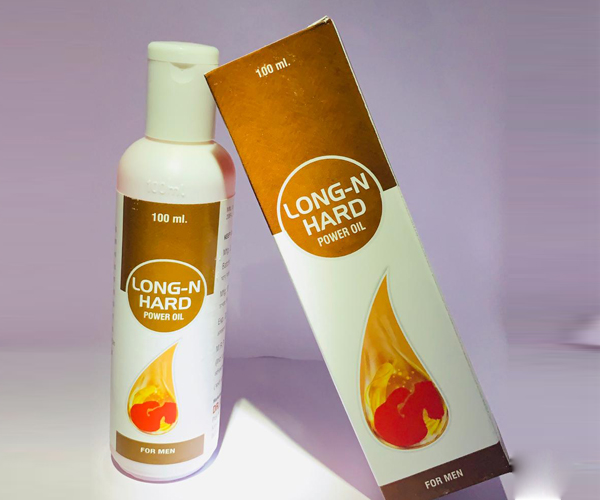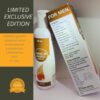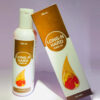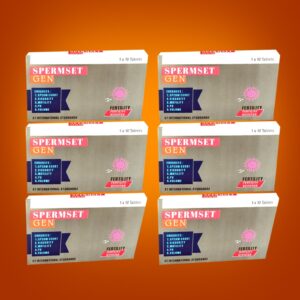Description
World class ingredients are
CROCUS SATIVA
Patients underwent the nocturnal penile tumescence (NPT) test and the international index of erectile function questionnaire (IIEF-15) at the start of the treatment and at the end of the ten days. After the ten days of massage with CROCUS SATIVA there was a statistically significant improvement in tip rigidity and tip tumescence as well as base rigidity and base tumescence. ILEF-15 total scores were significantly higher in patients after Crocus Sativa massage (before treatment 22.15+/-1.44; after treatment 39.20+/-1.90, p<0.001).
SESAMUM INDICUM
The second most abundant phytochemical in the Sesamum indicum oil is alkaloid with a concentration of 132.80±0.15 mg/g. Alkaloids have been used as central nervous system stimulants, topical anesthetics.
Proximate composition and physicochemical analyses were carried out on the seed and Sesame oil(Sesamum indicum L.). The results showed that the seed contained 5.7% moisture, 20% crude protein, 3.7%ash, 3.2% crude fiber, 54% fat and 13.4% carbohydrate. The seeds were found to be good sources of minerals. Potassium (851. 35 ± 3.44 mg/100g) was the highest, followed in descending order by Phosphorus (647.25±3.52 mg/100g), Magnesium (579.53 ± 0.42 mg/100g), Calcium (415.38 ± 3.14 mg/100g) and Sodium (122.50± 4.21 mg/100g).The physical properties of the oil extracts showed the state to be liquid at room temperature.The oil was found to contain high levels of unsaturated fatty acids, especially oleic (up to 38.84%) and linoleic(up to 46.26% ). Sesamum indicum L. oil can be classified in the oleic-linoleic acid group. The dominantsaturated acids were palmitic (up to 8.58%) and stearic (up to 5.44%). The oil extracts exhibited goodphysicochemical properties for penile muscle.
MATRICARIA CHAMOMILLA
(GERMAN CHAMOMILE)
Increases Thickening or the Grith of your organ.
Active constituents that are found in Chamomile include the following: apigenin and alpha-bisabolol, other compounds in chamomile include: sesquiterpenes, terpenoids, flavonoids, coumarins such as herniarin and umbelliferone, phenylpropanoids such as chlorogenic acid and caffeic acid, flavones such as apigenin and luteolin, flavanols such as quercetin and rutin, and polyacetylenes. The combination of these chemicals provide the claimed health benefits.
OLEA EUROPOEA
naturally rich in vitamins A and E, as well as the powerful hydroxytyrosol, which has anti-inflammatory effects and is free radical fighting. The oil can penetrate the skin, prevent loss of moisture and give a silky smooth softness.
It consists primarily of the glycerides of the fatty acids linoleic, oleic and palmitic. oil is beneficial for dry skin because of its fatty acid content, some of which comes from the emollient squalene.
RICINUS COMMUNIS
Antioxidants are the first line of defence towards free radical damage and play a significant role in maintaining cell viability and optimum health. Many of the neurodegenerative diseases are related to free radicals exposure to the cell. The DPDH (1,1- diphenyl-2-picryohydrazyl) mediated in vitro study, reveals the antioxidant activity of R. communis due to the presence of compounds such as gallic acid, quercitin, gentisic acid, rutin, epicatechin and ellagic acid in leaves and methanolic extract. In another study, the antioxidant activity of R.
CELASTRUS PANICULATUS
Celastrus seed oil is most commonly used for its supposed cognitive-boosting properties.
celastrus Paniculatus oil exercised for a longer period and had less muscle and DNA damage.
Celastrus paniculatus oil is extracted from seeds contains alkaloids, sterols, and bright coloring substance, celapanine, celapanigine, celapagine, celastrine, and paniculatine are some of the important alkaloids is rich in oleic acid (54.42%), which is the main fatty acid in the oil, together with linoleic acid (15.51%), palmitic acid (20.0%) and stearic acid (4.18%)12,13 Celastrus paniculatus also contains sesquiterpene like dipalmitoyl glycerol and alkaloids.
CELASTRUS PANICULATUS is an effective nervine tonic which strengthens the nerves of the penis.
JASMINUM GRANDIFLORUM
It is used to cause relaxation (as a sedative), to heighten sexual desire (as an aphrodisiac).
Methyl jasmonate isolated from the jasmine oil of Jasinum gradiflorum led to the discovery of the molecular structure of the jasmonate plant hormones.
The plant parts exhibit astringent/acrid, thermogenic/ heat generating, aphrodisiac, increase flow of blood in pelvic region, and sedative properties and used in the treatment of Depression, nervous exhaustion, stress related conditions. contain major phytoconstituents as glycosides, saponins, flavonoids and terpenoids. In this study, the phytochemical screening and anti-lipid peroxidation effect of J.sambac was evaluated using the standard antioxidants BHT, Vitamin C, Vitamin E and Rutin. The preliminary study shows the presence of alkaloids, flavonoids, terpenoids, carbohydrates, proteins, phenols, tannins, saponins and phytosterols. The methanolic extract of the J.sambac flowers shows anti-lipid peroxidative effect which is similar to that of all standards.
MYRISTICA FRGRANS
Helps to produce Nitric oxide a compound in the body that causes blood vessels to widen and stimulates the release of certain hormones. Brings nutrition to the penile muscles.
The major chemical constituents of Myristica fragrans are alkyl benzene derivatives (myristicin, elemicin, safrole) myristic acid, alpha-pinene, terpenes, beta-pinene and trimyristin.
@@@@@@@@@@@@@@
The penis is an external organ of the male reproductive system. It has two main functions:
Sexual intercourse – During erotic stimulation, the penis undergoes erection, becoming engorged with blood. Following emission, (mixing of the components of semen in the prostatic urethra) ejaculation can occur, whereby semen moves out of the urethra through the external urethral orifice. Finally, the penis undergoes remission, returning to a flaccid state.
Micturition – The penis also has an important urinary role. It contains the urethra, which carries urine from the bladder to the external urethral orifice, where it is expelled from the body.
In this article, we will look at the functions and structure of the penis and how these give rise to certain clinical conditions.
Note: In the anatomical position the penis is erect, so the dorsal side is that closest to the abdomen and the ventral side is closest to the testes.
Structure of the Penis
The penis can be anatomically divided into three parts:
Root – the most proximal, fixed part of the penis. It is located in the superficial perineal pouch of the pelvic floor, and is not visible externally. The root contains three erectile tissues (two crura and bulb of the penis), and two muscles (ischiocavernosus and bulbospongiosus).
Body – the free part of the penis, located between the root and glans. It is suspended from the pubic symphysis. It is composed of three cylinders of erectile tissue – two corpora cavernosa, and the corpus spongiosum.
Glans – the most distal part of the of penis. It is conical in shape, and is formed by the distal expansion of the corpus spongiosum. This contains the opening of the urethra, termed the external urethral orifice.
Erectile Tissues
The erectile tissues fill with blood during sexual arousal, producing an erection. The root and body of the penis are spanned by three masses of erectile tissue.
In the root, these tissues are known as the left and right crura, and the bulb of the penis. The bulb is situated in the midline of the penile root, and is traversed by the urethra. The left and right crura are located laterally; attached to the ipsilateral ischial ramus, and covered by the paired ischiocavernosal muscles.
The erectile tissues continue into the body of the penis. The left and right crura continue anteriorly into the dorsal part of the penis – they form the two corpora cavernosa. They are separated by the septum of the penis, although often incompletely. The bulb forms the corpus spongiosum, which lies ventrally. The male urethra runs through the corpus spongiosum – to prevent it becoming occluded during erection the corpus spongiosum fills to a reduced pressure.
Distally, the corpus spongiosum expands to form the glans penis.
By TeachMeSeries Ltd (2020)
Muscles
There are four muscles located in the root of the penis:
Bulbospongiosus (x2) – associated with the bulb of the penis. It contracts to empty the spongy urethra of any residual semen and urine. The anterior fibres also aid in maintaining erection by increasing the pressure in the bulb of the penis.
Ischiocavernosus (x2) – surrounds the left and right crura of the penis. It contracts to force blood from the cavernous spaces in the crura into the corpus cavernosa – this helps maintain erection.
Fascial Coverings
Each mass of erectile tissue has two fascial coverings. The most superficial layer, immediately under the skin, is the external fascia of Colles (which is in continuity with the fascia of Scarpa which covers the abdominal wall).
Ligaments
The root of the penis is supported by two ligaments, which attach it to the surrounding structures:
Suspensory ligament – a condensation of deep fascia. It connects the erectile bodies of the penis to the pubic symphysis.
Fundiform ligament – a condensation of abdominal subcutaneous tissue. It runs down from the linea alba, surrounding the penis like a sling, and attaching to the pubic symphysis.
Skin
The skin of the penis is more heavily pigmented than that of the rest of the body. It is connected to the underlying fascias by loose connective tissue.
The penis with the prepuce retracted in order to reveal the glans. Note the skin fold of the frenulum (arrow).
To manually stretch your penis:
Grip the head of your penis.
Pull your penis upward, stretching it out for about 10 seconds.
Pull your penis to the left for another 10 seconds, then to the right.
Repeat these steps once or twice a day for about 5 minutes.
Or try this:
Grip the head of your penis.
Pull your penis upward.
Press on the area around the base of your penis at the same time.
Hold this position for about 10 seconds.
Repeat these steps with your penis pulled to the left, applying pressure to the base of your penis on the right side.
Repeat these steps with your penis pulled to the right, applying pressure to the base of your penis on the left side.
Repeat this exercise once a day for up to 2 minutes.
To “jelq” your penis:
Put your index finger and thumb in an O shape.
Place the O-shaped gesture at the base of your penis.
Make the O smaller until you put mild pressure on your penis shaft.
Slowly move your finger and thumb toward the head of your penis until you reach the tip. Reduce the pressure if this feels painful.
Repeat this twice per day for about 20 to 30 minutes










Reviews
There are no reviews yet.